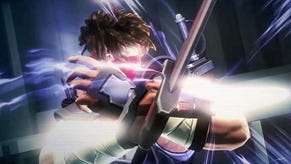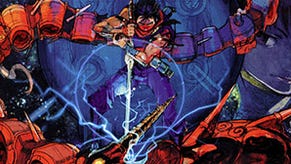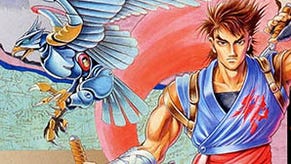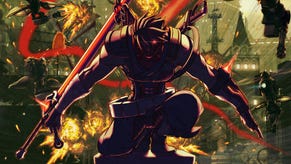Strider: the reboot-proof hero gets his second coming - interview
Strider Hiryu has endured as one of Capcom's cherished heroes, but the company has pained over his return for many years. VG247's Dave Cook speaks with the publisher about Double Helix Games' incoming reboot, and other failed projects.
”Not all elements in every game age gracefully, but there are those elements which stand the test of time and remain fresh in people’s minds. Understanding and expanding upon these elements is key to modernizing a classic game.”
When it was first released in Japanese arcades in 1989, Strider offered gamers a new proposition. It forced them to think differently about height and traversal, thanks to its protagonist's wall-scaling abilities, and it meant that you no longer depended on ascending platforms to achieve feats of sheer verticality; just something solid to hold on to.
Kouichi Yotsui came up with the concept after he locked himself on Capcom's roof during the height of Japanese winter. When it became clear that he was freezing to death he started to climb down the building, towards the nearest fire escape. One wrong foot would have seen him plummet to the streets below, but thankfully he lived to tell the tale and worked the notion of climbing and aerial feats into the Strider Hiryu concept.
It's a magnificent tale, and while the Strider series hasn't spawned more eye-popping anecdotes than this, there are many untold stories behind the license. With the Strider reboot hitting Japan this February - courtesy of Killer Instinct team Double Helix Games - I decided it was high time to pop a few questions to Capcom regarding the series, its many canned reboot attempts, and the new game itself.
"The concepts are not related," Capcom producer James Vance replied when I asked him if the Double Helix Strider reboot and Grin's failed sequel had anything in common. "To be honest, the first time I, and certainly the staff at Double Helix, learned about the Grin game was when the concept CG trailer appeared on the internet. The Grin 'real-world' rendition is an interesting take on the series, and is perhaps an avenue to be explored down the line.
"For our game, however, we felt that the surreal, analog-future design of the Strider universe is a key component of the series’ lasting appeal, and chose to focus on delivering this as one of our key game pillars rather than explore a more realistic approach."
Vance explained that Double Helix pitched several classic series reprisals to Capcom, but revealed that its Strider pitch ended up swaying the company, as well as some of the old guard who were present when the initial game launched. Interestingly, Vance added that he was asked to pitch his own vision of what a Strider reboot should look like when he first started at Capcom. He revealed that he pitched the Double Helix concept right back at the board, re-affirming the decision. Work on the project began and here we are less than a month from its Japanese launch.
While Strider is a reboot of the classic release; focusing on the assassin's encounter with the villainous Grand Master Meio, it takes a more open approach. Vance reckoned, "An average first time player will probably finish the game in around 7-8 hours, but much more time will be required to unlock every secret, additional game mode and explore every nook and cranny of the game world.” It's closer to Metroid in terms of map exploration, but it doesn't start with a lack of skills. Vance stressed that Hiryu is going to be highly skilled and combat-ready when he first drops into the game world.
"When the player begins the game as Strider Hiryu they have all of his core abilities and more," Vance explained. "They are extremely agile, can cling to and climb on almost anything and punish opponents with lightning fast, ultra-responsive Cypher [sword] attacks. The sprawling, verticality of the game world challenges the player to utilize their core abilities to the utmost, and then push them even further.
”The passion for, and understanding of the original games has been the number one driving force on the project. We are all huge fans who grew up with Strider on the Genesis/Mega Drive, and push every aspect of the game to delivery on the quintessential Strider experience.”
"All of the weapon and ability upgrades branch out from the core abilities, thus introducing new gameplay that serves as the key to progressing further and exploring deeper into the world, but at the same time ensure players will enjoy the core Strider gameplay mechanics."
One such mechanic sees players switching between different 'Plasma' types imbued within Striders Cypher tonfa sword and his kunai. By using different weapon states such as 'Ultra-Cold', 'Explosive' and 'Reflect,' players can exploit their enemy's weakness. They each have alt-modes and support buffs, which add significant depth to combat. The Reflect Plasma can be triggered to create a bullet-deflecting sword attack that enables you to counter bullets. It's only a fleeting support skill however. Vance warned me that some enemies are capable of raining down bullet hell. In short: you can't counter them all, so aggression is required.
Vance revealed that some attacks will be familiar to Hiryu's command list in Marvel vs Capcom, and stressed that Strider is a reboot formed by some proper, hardcore fans of the series - at Capcom and Double Helix alike. "The most important thing is to try and understand what it was about previous games that people remember most fondly," he added, "rather than focusing solely on what the previous games actually were. Not all elements in every game age gracefully, but there are those elements which stand the test of time and remain fresh in people’s minds. Understanding and expanding upon these elements is key to modernizing a classic game without fear of losing the essence that fans hold so close to their hearts.
"Our three key pillars are the hero Strider Hiryu, the unique look and feel of the Strider Universe, and the extreme agility and responsiveness of the character. The first order of business on the project was to get Hiryu right. A truly extensive amount of time was invested in creating Hiryu’s model, working and reworking literally every individual piece until he was just right. Our Art Director, Mr. Sakai (Strider 2 character designer), created the design and ensured that it was satisfactory down to the last detail. Extremely talented staff at Double Helix then rigged and animated the model so that he moved, reacted and felt like the Hiryu fans, and Capcom have come to expect."
Add to this many new and returning bosses such as Ouroboros and Mechapon, along with three difficulty modes, a brutal challenge for the veterans, and a truckload of respect for the source material, and you could be looking at one of the better reboots to come out of the industry in some time. We're yet to play Strider however, so this could swing either way. I'm personally hopeful however, as a fan of the original. My original Mega Drive Strider cartridge still holds pride of place on my shelf of retro games to this day.
I asked Vance what set this reboot apart from other, failed attempts at bringing Strider into the modern age. He replied, "The passion for, and understanding of the original games has been the number one driving force on the project. We are all huge fans who grew up with Strider on the Genesis/Mega Drive, and push every aspect of the game to delivery on the quintessential Strider experience. Strider is without a doubt a game by the fans for the fans."
He added that to really nail this game, both Capcom and Double Helix weren't precious about content, and readily scrapped anything that either didn't work, or perhaps felt out of place. "It’s very important, particularly for an action centric game, to be willing to tweak, re-create or remove mechanics and concepts so that the final product looks and feels right," he concluded. "There is never really any question of willingness; time and budget are the limiting factors.
"The most challenging element in creating this Strider was to ensure that the game world and enemy characters provided the right challenge for the player’s abilities and skill sets upon the progression path. This required that a large degree of tweaking take place on certain areas of the world map, and in some cases entire areas of the map be reworked or even removed. Enemy actions and movements were also rigorously tuned. Some enemies and world areas did not make the final cut but may find their way back in future games some day."
The promise of future Strider games without another years-long wait certainly makes this critic hopeful that Double Helix has pulled it off. More good Strider games would surely be welcome among fans, but we'll know for certain how likely a future follow-up will be once we get the final code in our hands. Until then, let us know what you think of the Strider reboot below.












